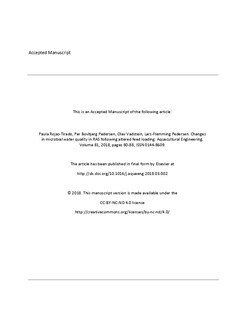| dc.contributor.author | Rojas-Tirado, Paula | |
| dc.contributor.author | Pedersen, Per Bovbjerg | |
| dc.contributor.author | Vadstein, Olav | |
| dc.contributor.author | Pedersen, Lars-Flemming | |
| dc.date.accessioned | 2019-10-04T09:15:06Z | |
| dc.date.available | 2019-10-04T09:15:06Z | |
| dc.date.created | 2018-05-10T09:56:38Z | |
| dc.date.issued | 2018 | |
| dc.identifier.citation | Aquacultural Engineering. 2018, 81 80-88. | nb_NO |
| dc.identifier.issn | 0144-8609 | |
| dc.identifier.uri | http://hdl.handle.net/11250/2620260 | |
| dc.description.abstract | Intensive recirculating aquaculture systems (RAS) with its hyper-eutrophic water offer ideal conditions for bacterial growth, abundance and activity, potentially affecting fish and system performance. Feed composition and feed loading in particular will have significant impact on organic and inorganic nutrients available for microbial growth in RAS. How these nutrient inputs affect and regulate bacteria in RAS water is, however, unclear. To investigate this relationship and the associated water quality dynamics, the effects of altered feed loading on microbial water quality in RAS was studied.
The study included six independent, identical pilot-scale RAS, each with a total volume of 1.7 m3 (make-up water: 80 L/day) stocked with juvenile rainbow trout (Oncorhynchus mykiss). All systems had been operating with constant and identical feed loading of 3.13 kg feed/m3 make-up water for a period of three months before the experiment was initiated. Three controlled levels of feed loading where established in duplicates: no feed (0 kg feed/m3), unchanged feeding (3.13 kg feed/m3), and doubled feeding (6.25 kg feed/m3). The experimental period was seven weeks, where microbial and chemical water quality was monitored weekly. Bacterial activity was measured using Bactiquant®, and microbial hydrogen peroxide degradation. Bacterial abundance was quantified by flow cytometry, and water quality parameters by standardized methods The study showed that water quality as well as bacterial activity and abundance were affected by the changes in feed loading. The microbial water quality parameters, however, did not respond to feed loading changes as quickly and straightforward as the physicochemical parameters such as nitrate, chemical oxygen demand and biological oxygen demand. It was presumed that the fixed bed biofilter suppressed microbial response in the water phase. Hydrogen peroxide degradation assay proved to have considerable potential for assessing overall bacterial load in RAS water although further adjustments and standardization procedures are required. | nb_NO |
| dc.language.iso | eng | nb_NO |
| dc.publisher | Elsevier | nb_NO |
| dc.rights | Attribution-NonCommercial-NoDerivatives 4.0 Internasjonal | * |
| dc.rights.uri | http://creativecommons.org/licenses/by-nc-nd/4.0/deed.no | * |
| dc.title | Changes in microbial water quality in RAS following altered feed loading | nb_NO |
| dc.type | Journal article | nb_NO |
| dc.type | Peer reviewed | nb_NO |
| dc.description.version | acceptedVersion | nb_NO |
| dc.source.pagenumber | 80-88 | nb_NO |
| dc.source.volume | 81 | nb_NO |
| dc.source.journal | Aquacultural Engineering | nb_NO |
| dc.identifier.doi | 10.1016/j.aquaeng.2018.03.002 | |
| dc.identifier.cristin | 1584457 | |
| dc.relation.project | Norges forskningsråd: 247558 | nb_NO |
| dc.description.localcode | © 2018. This is the authors’ accepted and refereed manuscript to the article. Locked until 22.3.2020 due to copyright restrictions. This manuscript version is made available under the CC-BY-NC-ND 4.0 license http://creativecommons.org/licenses/by-nc-nd/4.0/ | nb_NO |
| cristin.unitcode | 194,66,15,0 | |
| cristin.unitname | Institutt for bioteknologi og matvitenskap | |
| cristin.ispublished | true | |
| cristin.fulltext | postprint | |
| cristin.qualitycode | 1 | |

